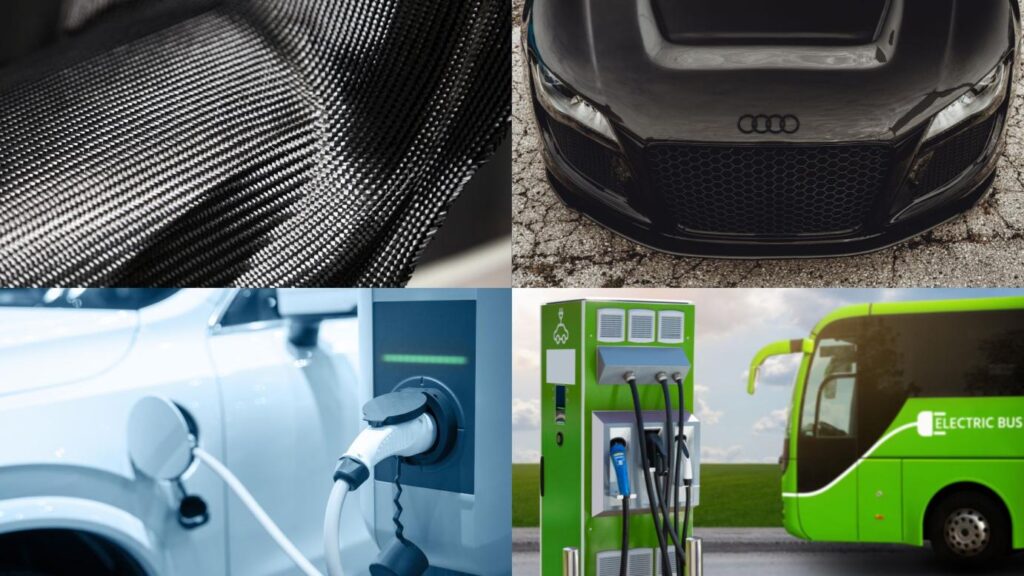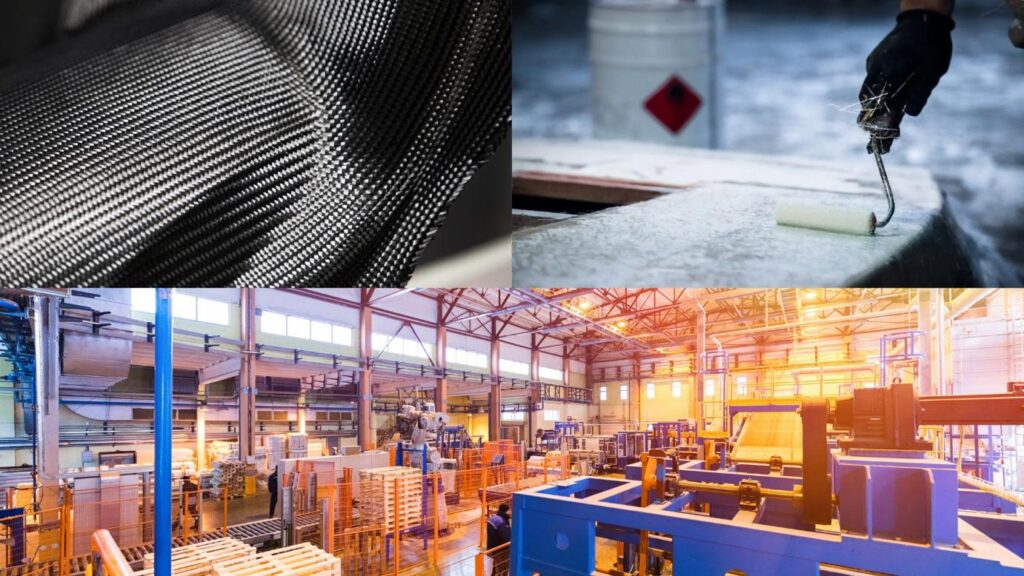Introduction to Metal Matrix Composites
Metal matrix composites (MMCs) are a special class of materials that consist of a metallic matrix reinforced with a secondary phase such as ceramics or carbon. MMCs exhibit superior mechanical properties such as high specific strength, specific modulus, and good wear resistance compared to monolithic metals and alloys. This makes MMCs attractive for applications in the aerospace, automotive, electronic packaging, thermal management, and wear parts industries where weight savings and improved performance are critical.
Aluminum, magnesium, titanium, and copper are the most common matrix materials used in MMCs while reinforcements include silicon carbide, alumina, carbon nanotubes, and graphene. The tailored combination of the matrix and reinforcement results in a composite material that is lighter and stiffer than the base metal. The reinforcements also enhance properties such as hardness, creep resistance, fatigue strength, fracture toughness, thermal conductivity etc. compared to the matrix material.
Applications of MMCs
The excellent strength-to-weight ratio and stiffness of MMCs make them ideal for weight critical applications in the aerospace and automotive industries. MMCs are used to produce lightweight and durable components such as:
- Engine components
- Brake discs
- Driveshafts
- Spacecraft and missile structures
- Wings and tails of aircraft
The low coefficient of thermal expansion and high thermal conductivity of MMCs allow their use in electronic packaging as baseplates, lead frames, and heat sinks for managing thermal stresses and heat dissipation in microelectronic devices.
Other applications of MMCs include:
- Cutting tools and wear inserts for machining as they maintain hardness at high temperatures
- Biomedical implants like orthopedic and dental implants owing to their biocompatibility
- Sporting goods such as golf clubs, bicycle frames, and archery equipment
Fabrication of MMCs
MMCs are fabricated using both solid state and liquid state processing methods.
Solid state processes involve:
- Powder metallurgy
- Diffusion bonding
- Physical vapor deposition
Liquid state processes include:
- Stir casting
- Infiltration
- Spray deposition
Powder metallurgy involves blending of matrix powders with reinforcement particles followed by compaction and sintering to produce components close to their final shape. This technique allows uniform distribution of fine reinforcements.
Stir casting is the most economical process and produces composites with up to 30% volume fractions of reinforcement. Here, the reinforcing phase is incorporated into the molten matrix metal which is then cast into the desired shape.
Properties of MMCs
MMCs derive their enhanced properties mainly due to presence of the reinforcements and their interaction with the matrix.
Mechanical properties
- The reinforcements improve the strength, stiffness and hardness of the matrix.
- The thermal mismatch between the matrix and reinforcement results in dislocation generation during processing leading to dispersion strengthening. -Transfer of stresses from matrix to the strong and stiff reinforcements provides load sharing effect.
- Fatigue strength and resistance to creep is also improved.
| Property | Enhancement |
|---|---|
| Tensile strength | 20-40% |
| Tensile modulus | 10-20% |
| Fatigue strength | 60-70% |
Physical properties
- Reinforcements like SiC and carbon improve the wear resistance.
- Electrical and thermal conductivity can be tailored by choice of reinforcements.
- Coefficient of thermal expansion is lower than base metal resulting in higher thermal shock resistance.
Overall, MMCs expand the property profile of monolithic metals allowing their use under more demanding conditions. The continuing research aims to develop affordable MMCs optimized for advanced applications.
Challenges in MMCs
Some challenges still exist in the fabrication and application of MMCs:
- Achieving uniform distribution of reinforcements
- Minimizing porosity in cast MMCs
- Improving wettability between matrix and reinforcements
- Reducing raw material and fabrication costs
- Joining and machining of MMC components
Extensive research is being carried out to address these issues and make metal matrix composites more viable commercially.
The Future of MMCs
The global metal matrix composites market size was over USD 300 million in 2021 and is projected to grow at 8% CAGR during 2022-2030 as per Expert Market Research. With the rising adoption of MMCs, especially aluminum MMCs in the automotive and aerospace sectors, the consumption of these materials will see steady growth in the coming decade.
Newer applications of MMCs include sporting goods, radiation shielding, armor, and biomedical implants. The use of nano reinforcements and hybrid composites is also being explored to further enhance the properties and performance.
Overall, MMCs offer an attractive materials solution for the transportation, electronics, and other demanding industries owing to their lightweight, strength, and design flexibility. Continued innovation in processing and cost reduction will drive wider commercialization of metal matrix composites.
Common Types of Metal Matrix Composites
The most commonly used metal matrices for composites are aluminum, magnesium, titanium and copper alloys. The choice of matrix material depends on the desired properties, compatibility with reinforcements, and feasibility of fabrication.
Aluminum Matrix Composites
Aluminum alloys are the most popular and widely used matrix materials for MMCs. Aluminum matrix composites (AMCs) offer high specific strength and modulus, excellent wear resistance and thermal properties. The key advantages of using aluminum alloys as the matrix include:
- Low density – Al has a density of 2.7 g/cm3 leading to lightweight composites
- High strength and modulus
- Good corrosion resistance
- High thermal and electrical conductivity
- Easy availability and low cost
- Possibility of recycling aluminum
- Good machinability of aluminum alloys
The commonly used aluminum alloys for MMC matrices are:
- 2xxx series alloys like 2024, 2026 with Cu as the major alloying element
- 5xxx series alloys such as 5083, 5056 containing magnesium
- 6xxx series alloys which have both magnesium and silicon as alloying elements
The most preferred reinforcements for AMCs are silicon carbide, alumina, graphite, and carbon nanotubes. Up to 40% volume fractions of reinforcements can be incorporated in AMCs using fabrication processes like stir casting and powder metallurgy.
AMCs are used for cylinder blocks, pistons, brake rotors, aircraft struts, electronic packaging, cutting tools, etc. Global aluminum MMCs market will reach USD 2.5 billion by 2027 as per Fior Markets report.
Magnesium Matrix Composites
Magnesium matrix composites (MMCs) have gathered interest in recent years due to excellent specific properties of magnesium. With a density of 1.7 g/cm3, magnesium is the lightest structural metal. Magnesium alloys have high strength-to-weight ratio, good castability, machinability and damping capacity.
Some limitations of using magnesium alloys as matrix are high chemical reactivity and poor elevated temperature properties. This can be overcome by reinforcing magnesium with ceramics like SiC, graphite or aluminum oxide.
Key characteristics of MMCs:
- Lower density compared to aluminum composites
- Higher specific stiffness than aluminum
- Improved creep resistance
- Lower coefficient of thermal expansion
- Good vibration damping
Potential applications of magnesium MMCs are in the automotive industry for engine blocks, transmission casings and steering wheels. Aircraft seat frames, luggage containers are other possible uses. The global magnesium composites market is projected to reach USD 4.5 billion by 2030 as per ReportLinker.
Titanium Matrix Composites
Titanium alloys have very high strength-to-weight ratio, excellent corrosion resistance and ability to withstand high temperatures. However, their applications are limited by high cost.
Titanium matrix composites (TMCs) allow lowering the cost while retaining the benefits of titanium alloys. The reinforcements commonly used in TMCs include TiB, SiC, graphite, and B4C. These improve the ambient and high temperature strength, stiffness and wear resistance compared to titanium alloys.
Key properties and advantages of TMCs:
- High specific strength retained to over 400°C
- Lower density than nickel alloys
- Better corrosion resistance than aluminum or steels
- Bio-inertness allows biomedical uses
- Good damage tolerance
TMCs are used for aircraft engine blades, discs, casings; spacecraft propulsion systems and structural parts; power generation turbines; biomedical implants; sporting goods. According to Data Bridge Market Research, TMCs market will reach USD 521 million by 2029.
Copper Matrix Composites
Copper matrix composites (CuMCs) find niche applications requiring high thermal or electrical conductivity along with improved mechanical properties. Pure copper has very high thermal (400 W/mK) and electrical conductivity (5.8 x 107 S/m).
Some drawbacks of copper are low strength, poor wear resistance and susceptibility to corrosion. These shortcomings are overcome by adding reinforcements like SiC, carbon fiber, alumina, WC, ZrB2 etc.
Salient features of copper MMCs:
- Very high thermal and electrical conductivity
- Improved strength and hardness
- Better wear, abrasion and creep resistance
- Retention of properties at elevated temperatures
Typical applications of copper MMCs:
- Electrical contacts and lead frames
- Heat sinks and packages for microelectronics
- Welding electrodes
- Wear resistant bushings and bearings
- Brush materials for motors
Copper composites have niche applications where thermal management and conductivity are critical along with reasonable strength. Global copper based composites market size was over USD 280 million in 2020 as per Expert Market Research.
Key Reinforcements Used in Metal Matrix Composites
The reinforcements in MMCs act as strength and stiffness enhancers as well as functional fillers for improving properties like wear resistance, thermal conductivity etc. The commonly used reinforcements include particles, short fibers and continuous fibers of ceramics, carbon and glasses.
Silicon Carbide
Silicon carbide (SiC) is one of the most widely used and popular reinforcements for MMCs. It exists in various forms including particles, whiskers, nanotubes, fibers and nanowires. Key advantages of SiC as reinforcement:
- High hardness – 2800 Vickers
- High strength and elastic modulus
- Low density – 3.2 g/cm3
- High thermal conductivity
- Good chemical and thermal stability
- Wear resistance
SiC significantly improves the mechanical properties, creep resistance, thermal conductivity and wear behavior of MMCs. It is commonly used in aluminum, magnesium and titanium based MMCs with volume fractions ranging from 10% to 40%.
SiC reinforced MMCs are used for cylinder blocks, brake discs, cutting tools, aerospace components etc. The global SiC based composites market was USD 1.5 billion in 2021 according to Data Bridge Market Research.
Alumina
Aluminum oxide or alumina (Al2O3) is a popular ceramic reinforcement due to its high strength, stiffness, hardness and wear resistance along with chemical inertness and thermal stability. Key features of alumina as MMC reinforcement:
- High hardness – 1800 Vickers
- High elastic modulus – 300-400 GPa
- Melting point over 2000°C
- Resistant to chemical attack
Alumina improves the stiffness, wear resistance and high temperature properties of MMCs. However, low thermal conductivity of alumina can degrade the heat dissipation capacity in some applications.
Alumina reinforced aluminum and magnesium composites are used in aerospace, defense, automotive and electronic packaging sectors. The alumina based composites market is projected to reach USD 106 billion by 2027 as per ReportLinker.
Carbon Nanotubes
Carbon nanotubes (CNTs) possess extraordinary stiffness, tensile strength, thermal and electrical conductivity. Adding small amounts of CNTs as reinforcements imparts significant improvements in MMC properties:
- Tensile strength and elastic modulus increased by over 20%
- Hardness increased up to 200%
- Wear resistance improved by 60-700%
- Higher fatigue strength and fracture toughness
- Increased thermal conductivity
However, key challenges in using CNTs are high cost, agglomeration and achieving uniform dispersion in metal matrices. CNT reinforced MMCs are well suited for applications demanding combination of high strength, stiffness and thermal conductivity.
Graphene
Graphene is a single layer of carbon atoms arranged in a hexagonal lattice structure. It has record breaking mechanical, electrical and thermal properties that make it attractive as a nanofiller in MMCs. Key enhancements from graphene addition:
- Tensile strength increased by 40%
- Young’s modulus increased by 14%
- Thermal conductivity enhanced by up to 100%
- Electrical conductivity increased significantly
- Wear and corrosion resistance improved
Graphene can impart multi-functional properties to MMCs at very low additions of 0.1-0.3 wt%. However, the high cost of graphene production remains a challenge for commercialization.
Graphene reinforced MMCs are promising materials for aerospace, automotive, electronics, energy and coatings applications. The global graphene based composites market size is forecast to reach USD 198 million by 2028 according to Emergen Research.
Overall, reinforcements open up exciting opportunities for tailored property enhancement in metal matrix composites for advanced structural and functional applications.
Key Fabrication Methods for Metal Matrix Composites
Metal matrix composites are manufactured using a variety of solid state and liquid state fabrication techniques. The processing method controls critical factors like particle distribution, porosity, interfacial bonding, and cost.
Solid State Processing
Powder metallurgy is a popular solid state technique used extensively for MMC fabrication. The steps involve:
- Blending of matrix powder and reinforcement particles using ball milling to achieve uniform mixing
- Cold compaction of the blended powder into billets or preforms
- Sintering the compacted preforms below the melting point to produce fully dense materials
Powder metallurgy allows excellent control over reinforcement distribution and enables uniform dispersion of fine particles. Porosity levels in sintered products can be an issue. Complex shapes can be produced near net shape reducing machining costs.
Diffusion bonding involves stacking alternate layers of matrix foils and reinforcements followed by hot pressing under pressure. Solid state diffusion occurs at the interface producing bonds without reaching the melting point. Diffusion bonding facilitates alignment of continuous fiber reinforcements along preferred orientations.
Physical vapor deposition (PVD) techniques like sputtering, evaporation, and ion plating deposit matrix metal atoms on reinforcement substrates to synthesize the composite coatings. PVD is suitable for refractory reinforcements that are difficult to disperse in molten alloys. It allows deposition of uniform and adherent coatings.
Liquid State Processing
Stir casting is the simplest and most economical method used for MMC fabrication. Here the reinforcements are added to and mixed with the molten matrix metal using mechanical stirring followed by casting. This technique is scalable to mass production for up to 25% volume fractions of particles.
For higher volume fractions, infiltration process is used where matrix metal is made to infiltrate into a bed of packed ceramic preforms via capillary action. Pressure or vacuum assistance can be provided to enhance infiltration. Infiltration allows fabrication of composites with 30-60% reinforcement content.
Spray deposition involves spraying fine droplets of molten matrix metal onto a substrate where reinforcements are already deposited. The composite layer builds up through rapid solidification of sprayed droplets. This method ensures good interfacial bonding and uniform distribution of reinforcements.
Comparison of Methods
| Method | Reinforcements | Density | Production rate | Cost |
|---|---|---|---|---|
| Powder metallurgy | Particles, short fibers | Near full density | Medium | Moderate |
| Diffusion bonding | Continuous fibers | Full density | Low | High |
| Stir casting | Particles, short fibers | Porosity possible | High | Low |
| Spray deposition | Particles, short fibers | Moderate porosity | Medium | Moderate |
Each fabrication technique has its own advantages and limitations in terms of microstructural control, productivity, cost and application. Combining different processes can enable development of high quality and affordable metal matrix composites.
Mechanical Properties of Metal Matrix Composites
The mechanical behavior of MMCs is superior to unreinforced metals due to the presence of stiffer and harder reinforcements, interaction with the matrix and refined microstructure.
Strength
The strengths of MMCs are significantly higher than the matrix alloy due to various strengthening mechanisms:
- Load transfer – Stress transfer from ductile matrix to the strong ceramic reinforcements
- Orowan strengthening – Reinforcements act as obstacles to dislocation motion
- Hall-Petch effect – Reduction in grain size due to presence of reinforcements
- Thermal mismatch stresses – CTE difference between matrix and reinforcements leads to dislocation generation
The yield and tensile strengths of aluminum composites showed 40-100% increase with addition of 20% volume fraction SiC particles as per study by Lloyd. Particle size, shape, distribution and volume fraction influence the strengthening effect.
Stiffness
The elastic modulus of MMCs is also higher than the matrix due to inclusion of very high modulus reinforcements. For example, addition of 17% SiC boosted tensile modulus of 6061 Al alloy by 23% as reported by Kennedy et al.
The stiffness enhancement depends on the modulus and volume fraction of reinforcements. Reinforcements like SiC, Al2O3 and carbon fibers have modulus in the range of 200-800 GPa compared to 69 GPa for aluminum.
Hardness
The reinforcements are significantly harder than the matrix which increases resistance to indentation and abrasion. 50-60% improvement in hardness was achieved with 20% SiC reinforcement in Al-4Cu alloy as shown by Mazahery et al.
Hard reinforcements hinder dislocation movements and cause dislocation pile-ups near the interface leading to substantial hardness increment. The degree of enhancement depends on hardness differential between matrix and reinforcement.
Toughness
While reinforcements increase strength and stiffness of MMCs, they lower fracture toughness compared to unreinforced alloys. The difference in modulus between the matrix and ceramic particles causes stress concentrations that reduce crack initiation resistance.
However, in fiber reinforced MMCs, the high strength fibers can deflect propagating cracks leading to improved fracture toughness. The toughness also depends on fiber volume fraction, orientation and bonding strength.
Creep and Fatigue
The presence of thermally stable and strong reinforcements enhances the resistance of MMCs to creep and fatigue failure at elevated temperatures.
- Creep rates are lowered due to transfer of stresses from matrix to reinforcements.
- Reinforcements obstruct dislocation motion and grain boundary sliding.
- Fatigue crack initiation and growth is hindered by reinforcements.
Thus, MMCs expand the useful temperature range compared to unreinforced alloys in load bearing applications.
Physical Properties of Metal Matrix Composites
In addition to mechanical properties, the physical behavior of MMCs in terms of thermal, electrical and chemical properties can also be tailored by varying the reinforcements and processing conditions.
Thermal Conductivity
The thermal conductivity of MMCs depends on the conductivities of both matrix and reinforcements along with the interfacial bonding. Metals like aluminum, copper have high thermal conductivity in the range of 100-400 W/mK.
Ceramic reinforcements like SiC enhance conductivity but others such as alumina lower it. Carbon based reinforcements lead to significant increment in thermal conductivity. For instance, addition of 1% graphene increased thermal conductivity of copper matrix by 46% as per study by Bartolucci et al.
Electrical Conductivity
Most ceramic particle reinforcements are electrically insulating. Their addition lowers the electrical conductivity of the metal matrix composite compared to the base alloy. For example, 10% SiC reduced the electrical conductivity of aluminum 6061 matrix by around 80% as shown by Prabu et al.
However, carbon based nanoreinforcements like carbon nanotubes and graphene significantly improve the electrical conductivity due to their high intrinsic electrical conductivity. The long conductive pathway formed by carbon nanotubes leads to percolation and tunneling effects.
Coefficient of Thermal Expansion
The coefficient of thermal expansion (CTE) of MMCs lies between those of the matrix and the reinforcement. Ceramic particles like SiC and Al2O3 which have low CTE reduce the overall CTE of the MMC.
This leads to dimensional stability at high temperatures and reduction in residual stresses during heating/cooling cycles. The lower CTE improves thermal shock resistance. However, large CTE mismatch can negatively affect the interface bond strength.
Density
The density of MMCs is influenced by the relative volume fractions and densities of the matrix and reinforcements. While ceramic particles increase density, reinforcements like SiC have lower density than Al or Mg.
Overall, the density of MMCs can be maintained lower than base alloys by using low density reinforcements, and controlling volume fractions. This results in higher specific strength compared to unreinforced metals.
Wear and Corrosion
Ceramic reinforcements improve the wear resistance of MMCs significantly by hindering plastic deformation and material loss. The hard particles resist abrasive wear while enhanced surface hardness provides protection against adhesive wear.
Oxide particles like alumina also impart improved corrosion resistance. However, galvanic effects between matrix and conductive reinforcements need to be controlled to avoid accelerated corrosion. Overall, MMCs demonstrate superior tribological properties.
Thus, physical properties of metal matrix composites can be tailored through judicious selection of matrix, reinforcements and processing route for the intended application.
Applications of Metal Matrix Composites
The excellent mechanical properties and design flexibility provided by MMCs make them suitable for demanding applications across diverse sectors.
Automotive Industry
The automotive industry is one of the largest consumers of aluminum and magnesium composites driven by the need for lightweighting.
- Engine components like pistons, cylinder blocks, pumps use aluminum MMCs to withstand high stresses and temperatures
- Brake rotors and drums made from MMCs offer superior wear resistance during braking
- Al or Mg MMCs are used for drive shafts, suspensions, steering knuckles for higher strength
- Improved fatigue resistance allows use in wheels, rims and hubs
- Applications in transmission casings, oil pans requiring stiffness, heat resistance
Automotive MMCs market is projected to reach USD 4.5 billion by 2030 according to Expert Market Research.
Aerospace Applications
MMCs are extensively used in aircraft and spacecraft owing to their high specific strength and stiffness.
- Reinforced aluminum is used in fuselage skins, frames, ribs and wings
- Landing gear components, helicopter rotor shafts produced using MMCs
- Turbine blades, engine casings employ MMCs at high temperatures
- Satellite structures and instrument panels utilize aluminum or magnesium composites
- Titanium composites used for jet engine containment casings
Aerospace MMCs demand will grow steadily with increasing use of composites for structural parts to reduce weight.
Electronic Packaging
Silicon carbide and alumina reinforced aluminum composites provide excellent solutions for thermal management in microelectronics packaging.
- Lead frames and printed circuit boards use MMCs to enable heat dissipation
- Baseplates and heat sinks fabricated from MMCs prevent overheating of devices
- Higher thermal conductivity manages heating in high power electronics
- Dimensional stability provided by low CTE minimizes thermal stresses
Use of MMCs will rise with increasing power densities in electronic systems requiring efficient heat removal.
Wear Resistant Applications
The excellent wear properties of MMCs are advantageous in applications involving sliding contact and abrasion.
- Cutting tool inserts and machine tool parts utilize aluminum composites
- High speed machining of metals and composites use MMC cutting tools
- Copper MMCs used in sliding bearings and bushings
- Alumina reinforced aluminum used for heavy duty pistons
- Mining and ore processing applications employ wear resistant MMC components
Other Uses
- Sporting goods like golf clubs, bicycle parts using MMCs for stiffness and strength
- Radar equipment housings needing low coefficient of thermal expansion
- Biomedical implants including orthopedic devices and dental implants
- High end audio components to provide rigidity and damping
- Nuclear industry applications exploiting neutron absorption property of boron carbide
Thus, metal matrix composites are enabling advancement across diverse technology domains owing to their customizable property profile.
Challenges and Future Outlook for Metal Matrix Composites
While the performance benefits of MMCs are well established, some challenges need to be addressed for their wider commercial adoption. Extensive research is underway to unlock their full potential.
Cost Reduction
The high costs associated with raw materials and fabrication has limited mainstream engineering applications of MMCs.
- Expensive particulate reinforcements like SiC and carbon nanotubes increase materials costs.
- Fabrication processes have low productivity and high energy consumption.
- Secondary operations like machining are difficult due to abrasive reinforcements.
Developing lower cost reinforcements, improving manufacturing productivity and identifying economical applications will enhance the cost-competitiveness of MMCs.
Interface Bonding
A strong interfacial bond between the matrix and reinforcements is necessary to effectively transfer stresses and obtain optimal mechanical properties. However, a mismatch in physical and chemical properties affects the interface integrity.
- Differences in coefficient of thermal expansion induces stresses at the interface
- Chemical reactions can occur between matrix and reinforcements
- Presence of porosity due to incomplete wetting and shrinkage impair bonding
Better control over surface chemistry and using nanostructured reinforcements will help achieve superior interfacial bonding in MMCs.
Scale-up Processing
Most fabrication techniques for MMCs have been developed at laboratory scale. Challenges exist in scaling up to industrial production levels while retaining materials quality.
- Powder processing methods have issues with large part fabrication
- Molten metal handling is difficult with stir casting of large volumes
- Achieving uniformity of microstructure and properties is problematic
A concerted effort is required to design and implement large scale manufacturing processes for high volume production.
Advanced Composites
The full potential of MMCs will be realized by developing advanced composite systems using hybrid and nano reinforcements.
- Hybrid composites with two or more reinforcements will deliver synergistic properties.
- Nano-structured reinforcements provide extremely high interface area for property enhancement.
- Aligned reinforcements and tailored architectures will offer anisotropic properties.
New processing techniques need to be evolved for controlled synthesis of multifunctional and smart metal matrix composites.
Expanding Applications
Intensive research on advanced metal matrix composites is expected to open up applications in diverse areas:
- Automotive – engines, battery casings for electric vehicles
- Aerospace – turbine blades with directional properties
- Electronics – 5G communication systems, laser diode packages
- Biomedical – prosthetics, implants, medical devices
- Energy – batteries, supercapacitors, solar cells
- Nuclear – generation IV fission and fusion reactor components
The future looks bright for metal matrix composites as material solutions for extreme environment and high performance applications across industries.
Conclusion
Metal matrix composites represent an important category of advanced materials that are gaining increasing prominence due to their superior properties and expanding applications.
The incorporation of reinforcements like silicon carbide, alumina, graphene into ductile metal matrices leads to composites with much higher strength-to-weight ratio, stiffness, wear resistance, and thermal conductivity compared to monolithic alloys. MMCs also exhibit higher elevated temperature capability, fatigue life and creep resistance.
Aluminum, magnesium, copper and titanium alloys are the most widely used matrices owing to their lightness, strength and availability. Particulate, whisker, short fiber and continuous fiber reinforcements provide significant enhancements in both structural and functional properties.
A variety of solid state and liquid state fabrication routes have been developed with their own advantages and limitations in terms of microstructure control, cost and productivity. Powder metallurgy, stir casting, infiltration, spray deposition are the key techniques used for commercial scale MMC manufacturing.
The excellent specific properties of MMCs enable weight savings and improved performance in critical applications across the aerospace, automotive, electronics, defense and energy sectors. MMC components are increasingly replacing traditional materials for aircraft structures, engine parts, pistons, electronic substrates, cutting tools, and wear resistant components.
However, challenges related to cost reduction, interface bonding, scale-up production, advanced composite development need focused efforts for metal matrix composites to realize their full commercial potential.
With increasing adoption of MMCs in high performance applications, the global metal matrix composites market is projected to grow steadily at 8-10% CAGR during this decade to reach over USD 1.5 billion by 2030.
Continued research and development in advanced metal matrix composite systems will open up new avenues and expand the application envelope across diverse technology domains. MMCs are poised to make a major impact as engineering materials of the future owing to their customizable property profile and ever expanding capabilities.
What are metal matrix composites (MMCs)?
Metal matrix composites consist of a metallic matrix reinforced with a secondary ceramic, carbon or metallic phase. The metallic matrix is generally a ductile metal like aluminum, magnesium, copper etc. while the reinforcements include particles, short fibers or continuous fibers of ceramics such as silicon carbide, alumina, and carbon based materials.
What are the key benefits of MMCs over conventional metals?
MMCs exhibit superior mechanical properties such as:
- Higher strength and stiffness
- Improved hardness and wear resistance
- Better fatigue strength and creep resistance at elevated temperatures
- Higher fracture toughness
MMCs also have tailored physical properties like:
- Increased thermal conductivity
- Higher electrical conductivity
- Lower coefficient of thermal expansion
- Improved corrosion resistance
What are the typical metal matrices used in MMCs?
The commonly used metal matrices in MMCs include:
- Aluminum alloys – 2xxx, 6xxx and 7xxx series
- Magnesium alloys – AZ91, AM60, ZK60
- Titanium alloys – Ti-6Al-4V, Ti-6Al-2Sn-4Zr-6Mo
- Copper alloys – Cu-Cr, Cu-Cr-Zr
What are the key reinforcement materials used in MMCs?
The reinforcements commonly used in MMCs are:
- Silicon carbide – SiC particles, whiskers, nanotubes
- Alumina – Al2O3 particles and fibers
- Boron carbide – B4C particles
- Carbon nanotubes – CNTs
- Graphene nanosheets
What are the main fabrication methods for MMCs?
MMCs are manufactured using:
- Solid state methods – Powder metallurgy, diffusion bonding
- Liquid state methods – Stir casting, infiltration, spray deposition
Powder metallurgy and stir casting are most widely used techniques.
What are the applications of MMCs?
MMCs find applications in:
- Aerospace – Aircraft structural parts, engine components
- Automotive – Pistons, brake rotors, drive shafts
- Electronics – Heat sinks, lead frames, baseplates
- Defense – Armour materials, projectiles
- Sports – Golf clubs, bicycle parts
Why are MMCs preferred over unreinforced metals?
MMCs are preferred due to:
- Higher strength-to-weight ratio
- Improved stiffness and hardness
- Better creep and fatigue resistance
- Enhanced wear resistance and thermal conductivity
- Lower coefficient of thermal expansion
What are the limitations of MMCs?
Some limitations of MMCs include:
- High materials and fabrication cost
- Complex manufacturing and machining
- Lower ductility and fracture toughness
- Possible reactivity of matrix with some reinforcements
How are properties of MMCs improved compared to base metals?
Reinforcements enhance MMC properties by:
- Load transfer from matrix to reinforcements
- Grain refinement of matrix by reinforcements
- Generation of thermal mismatch stresses
- Orowan strengthening by impeding dislocation motion
What are the emerging trends in MMCs?
Some emerging trends in MMCs are:
- Use of nanostructured reinforcements like CNTs and graphene
- Development of hybrid composites with two or more reinforcements
- Fabrication of MMC foams and sandwich structures
- Modeling and simulation to optimize properties
- Expanding applications in electronics, biomedical and nuclear fields
What is the global market outlook for MMCs?
The global metal matrix composites market size is projected to grow from USD 883 million in 2021 to reach over USD 1.5 billion by 2030 at a CAGR of around 8-10% during the forecast period according to expert estimates.
What advances are expected in MMC technology?
Future advancements in MMCs include:
- Cost effective manufacturing processes
- Improved interface bonding
- Better understanding of structure-property relationships
- Modeling and simulation for design
- Hybrid and multifunctional composites
- High volume applications in automotive and aircraft sectors









